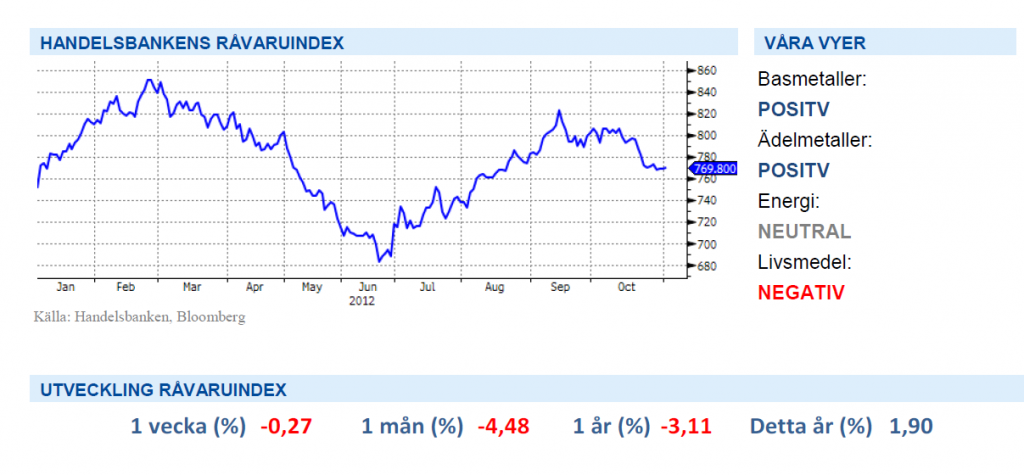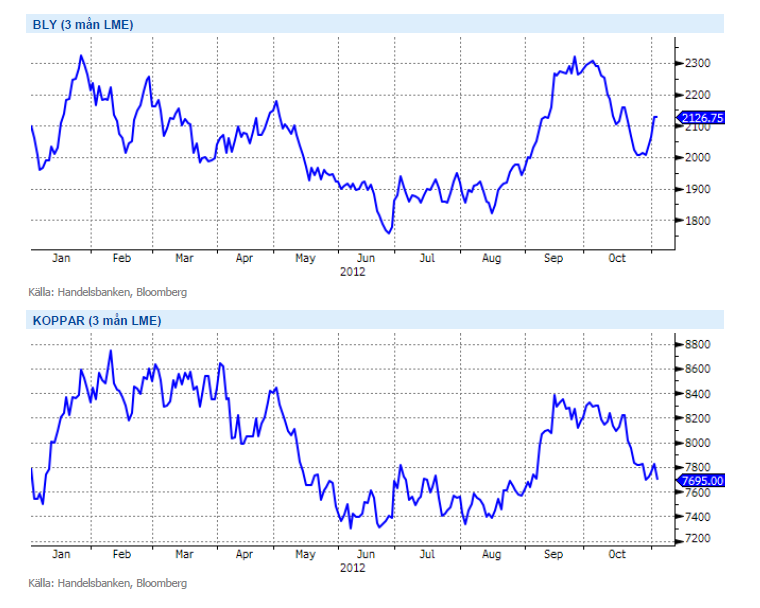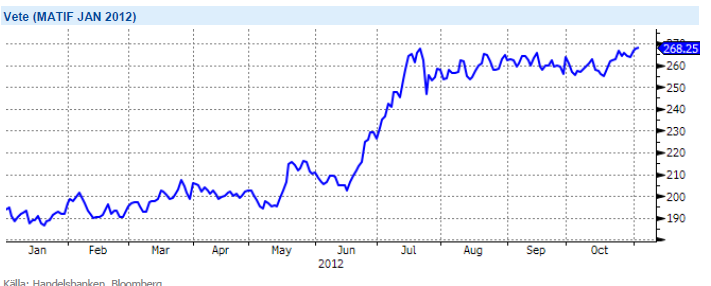Analys
SHB Råvarubrevet 2 november 2012
 Veckan bjöd på några gröna skott
Veckan bjöd på några gröna skott
Vi lämnar nu oktober och vi kan konstatera att månaden som gått bjöd på fallande priser på råvaror. Prisfallet på både metaller och energi ledde till att råvaror har haft det största fallet sedan maj under oktober månad med 4 %. Därmed ligger nedgången i paritet med börsen för samma period. Investerares optimism grusades av bland annat att IMF reviderade ner de globala utsikterna för tillväxt. Kina har rapporterat det sjunde kvartalet i rad med fallande tillväxt och inbromsningen i de 17 euroländerna fortsätter.
Bolagsrapporter har varit sämre än väntat och det har gjort att pessimism har spridit sig till råvarorna. Blickar vi framåt talar mycket för att Kinas ekonomi åter börjar få fotfäste och att botten på den kinesiska konjunkturen var under det tredje kvartalet. Veckan bjöd på några gröna skott i form av bra inköpschefsindex i USA och Kina. Den mest framåtblickande komponenten i inköpschefsindex, nya order, steg både i Kina och USA. Vi fortsätter därför att vara positiva till råvaror som tillgångsslag trots den motiga utvecklingen på marknaden under september. Antalet nya jobb i USA slog också förväntningarna idag och ger stöd åt USA:s återhämtning.
Basmetallerna
Är Kina på väg tillbaka?
Basmetallpriserna har under veckan utvecklats mestadels positivt. Alla metallerna har gått upp, med undantag för koppar som fallit cirka 1,3 % i pris. Zink och bly har visat på kraftiga uppgångar, upp respektive 2.2 % och 5,3 %. Under fredag eftermiddag föll basmetallerna på bred front på en förstärkt dollar.
Kopparpriset föll för den fjärde veckan i rad, främst till följd av höga lagernivåer i Shanghai. Uppgången i blypriset kunde förklaras med statistik som visade att produktionen hade fallit med 10 % i oktober, vilket var det största minskningen sedan i januari. Vi är fortsatt positiva till basmetallpriserna då vi ser tecken på att konjunkturen håller på att få upp farten i Kina och USA.
Buy on dips är intressant på basmetaller just nu. Under oktober har basmetallerna haft ett kraftigt ras, efter den kraftiga uppgången i september. Finansmarknaden hade handlat in för mycket på för kort tid. Däremot ser Kinadata allt bättre ut nu. Vi tror på: BASMET H
Ädelmetaller
Kalldusch för guldet efter jobbdata från USA
Positiva arbetsmarknadssiffror från USA och en stärkt dollar fick guldpriset att falla kraftigt under fredagseftermiddag. I skrivande stund handlas guldet på 1685 USD/uns – det är 1,85 % lägre än dagens öppning. Platinum har däremot stärkts under veckan från förra veckans nedgångar, men uppgången raderades under fredagen och platinum stänger veckan i oförändrad.
Arbetet vid guldgruvorna i Sydafrika är nu delvis återupptaget men utdragna rättsprocesser är att vänta. Gold Fields, världens fjärde största producent, uppskattar att strejkerna har kostat företaget uppåt 150 miljoner dollar.
Trots det senaste raset är vi fortsatt positiva till ädelmetaller där vi tror centralbanksstimulanserna är det största drivkraften.
Vi fortsätter att se centralbankernas nytryckta pengar och framförallt Feds QE3 operation som starkt skäl att vara investerad i ädelmetallerna. Konflikterna i Sydafrika fortsätter och ger stöd åt och guldpriset. Vi tror på: ADELMET H
Energi
Fortsatt svaga utsikter för elpriset
Oljepriset (Brent) har haft en fallande trend under veckan, efter positiva under fredag eftermiddag av positiva arbetsmarknadssiffror från USA steg priset 1,7 USD/fat men den uppgången raderades under eftermiddagen. Brent-oljan handlas nu på 107,70 USD/fat vilket är 1,2 % lägre än veckans öppning. Orkanen Sandy som svepte in över USA:s östkust tidigare i veckan har lämnat förstörelse och dödsfall efter sig. Orkanens framfart har även haft betydelse för oljepriset, främst priset på WTI-oljan som till motsats till Brent-oljan stigit under veckan. Mindre lager än väntat på råolja ger även det stöd till oljepriset. Amerikanska lager minskade med 2 miljoner fat mot en förväntad ökning på 1,8 miljoner fat.
Elmarknaden faller tillbaka närmare tre procent under veckan efter att såväl väder, spot, som tysk el verkat för lägre priser i Norden. Kol och utsläppsrätter handlas i stort sett oförändrat över veckan (89.50 dollar respektive 8 euro per ton) så inga större förändringar vad gäller brytpriset. Fokus är därmed återigen på vädret där temperaturen nu återgått till normala nivåer och ser ut att landa strax över normalt mot slutet av perioden. Energibalansen har förbättrats med närmare 2 TWh de senaste två veckorna (se blå graf nedan) och ser vi till prognoserna förväntas uppemot 7 TWh de kommande 10 dagarna vilket kan förbättra energibalansen med ytterligare någon TWh. Det är således svårt att motivera köp under rådande omständigheter, snarare sannolikt att marknaden faller tillbaka ytterligare 50 cent och testar 40 euro nivån för kvartalet Q1 2013 (underliggande för våra sparprodukter på el) om prognosen står fast över helgen. I övrigt noteras en stark tillväxt av vindkraft i kvartalsrapporten från Svensk vindenergi under 2012. 3,977 MW kommer att vara installerat i Sverige vid årsskiftet (ca 3% av Sveriges elanvändning) men pga av låga priser på el och elcertifikat förväntas endast 500 MW utbyggnad under 2013 (ca hälften av 2012 års installationer).
Oljan har sett allt svagare ut och vi fortsätter tycka att underliggande fundamenta är väl balanserad. Vi ser även att förutsättningarna för fortsatt lågt elpris kvarstår. Vi håller en neutral syn på energisektorn.
Livsmedel
Ökad oro för det amerikanska höstvetet
Terminspriser på vete har gått upp något sedan förra veckan i både Chicago och Paris. Det amerikanska höstvetet har längtat efter regn under en lång tid och skicket på grödan bedöms nu vara det värsta på 20 år vid den här tiden på året – vi har flera gånger sett att en dålig gröda lyckats återhämta sig väl efter vintern om vädret tillåter men helt klart har oron nu ökat. Det torra vädret har dock snabbat på sådden något, för vilken nu omkring 10 procent återstår. Något regn från stormen Sandy verkar inte ha nått de viktiga veteregionerna i USA i större utsträckning, vilket det talades mycket om i början av veckan.
Lite regn har fallit i Australien, möjligen kan det ha en positiv effekt på grödan längst ned i söder men generellt sett bedöms det vara för sent för att göra någon nytta. Fortsätter regnandet framöver lär det istället bli en nackdel då skörden i norr redan startat. I EU regnar det fortfarande i ganska stora delar och den del av sådden som kvarstår går sakta framåt, helt säkert kommer detta leda till en mindre höstsådd areal. I regndrabbade Argentina är skörden nu avklarad till omkring 6 procent, vädret har dock förbättrats något de sista dagarna men mer regn väntas under nästa vecka. I Östeuropa är det kallt och vetet börjar nu gå in i vintervila.
Väldigt mycket negativt är inprisat i dagens nivå och vi förväntar oss viss svårighet för priserna att nå så mycket högre. Långsiktigt är det svårt att se varför dagens nära rekordhöga priser ska hålla i sig – även om väldigt mycket kan hända till dess.
Vi ser soja, majs och vete som klara säljcase där vi väntar oss prisfall före jul men senast till påsk. Vi tror på: LIVSMEDEL S H
Handelsbankens Råvaruindex

Handelsbankens råvaruindex består av de underliggande indexen för respektive råvara. Vikterna är bestämda till hälften från värdet av global produktion och till hälften från likviditeten i terminskontrakten.
[box]SHB Råvarubrevet är producerat av Handelsbanken och publiceras i samarbete och med tillstånd på Råvarumarknaden.se[/box]
Ansvarsbegränsning
Detta material är producerat av Svenska Handelsbanken AB (publ) i fortsättningen kallad Handelsbanken. De som arbetar med innehållet är inte analytiker och materialet är inte oberoende investeringsanalys. Innehållet är uteslutande avsett för kunder i Sverige. Syftet är att ge en allmän information till Handelsbankens kunder och utgör inte ett personligt investeringsråd eller en personlig rekommendation. Informationen ska inte ensamt utgöra underlag för investeringsbeslut. Kunder bör inhämta råd från sina rådgivare och basera sina investeringsbeslut utifrån egen erfarenhet.
Informationen i materialet kan ändras och också avvika från de åsikter som uttrycks i oberoende investeringsanalyser från Handelsbanken. Informationen grundar sig på allmänt tillgänglig information och är hämtad från källor som bedöms som tillförlitliga, men riktigheten kan inte garanteras och informationen kan vara ofullständig eller nedkortad. Ingen del av förslaget får reproduceras eller distribueras till någon annan person utan att Handelsbanken dessförinnan lämnat sitt skriftliga medgivande. Handelsbanken ansvarar inte för att materialet används på ett sätt som strider mot förbudet mot vidarebefordran eller offentliggörs i strid med bankens regler.
Analys
Volatile but going nowhere. Brent crude circles USD 66 as market weighs surplus vs risk

Brent crude is essentially flat on the week, but after a volatile ride. Prices started Monday near USD 65.5/bl, climbed steadily to a mid-week high of USD 67.8/bl on Wednesday evening, before falling sharply – losing about USD 2/bl during Thursday’s session.

Brent is currently trading around USD 65.8/bl, right back where it began. The volatility reflects the market’s ongoing struggle to balance growing surplus risks against persistent geopolitical uncertainty and resilient refined product margins. Thursday’s slide snapped a three-day rally and came largely in response to a string of bearish signals, most notably from the IEA’s updated short-term outlook.
The IEA now projects record global oversupply in 2026, reinforcing concerns flagged earlier by the U.S. EIA, which already sees inventories building this quarter. The forecast comes just days after OPEC+ confirmed it will continue returning idle barrels to the market in October – albeit at a slower pace of +137,000 bl/d. While modest, the move underscores a steady push to reclaim market share and adds to supply-side pressure into year-end.
Thursday’s price drop also followed geopolitical incidences: Israeli airstrikes reportedly targeted Hamas leadership in Doha, while Russian drones crossed into Polish airspace – events that initially sent crude higher as traders covered short positions.
Yet, sentiment remains broadly cautious. Strong refining margins and low inventories at key pricing hubs like Europe continue to support the downside. Chinese stockpiling of discounted Russian barrels and tightness in refined product markets – especially diesel – are also lending support.
On the demand side, the IEA revised up its 2025 global demand growth forecast by 60,000 bl/d to 740,000 bl/d YoY, while leaving 2026 unchanged at 698,000 bl/d. Interestingly, the agency also signaled that its next long-term report could show global oil demand rising through 2050.
Meanwhile, OPEC offered a contrasting view in its latest Monthly Oil Market Report, maintaining expectations for a supply deficit both this year and next, even as its members raise output. The group kept its demand growth estimates for 2025 and 2026 unchanged at 1.29 million bl/d and 1.38 million bl/d, respectively.
We continue to watch whether the bearish supply outlook will outweigh geopolitical risk, and if Brent can continue to find support above USD 65/bl – a level increasingly seen as a soft floor for OPEC+ policy.
Analys
Waiting for the surplus while we worry about Israel and Qatar

Brent crude makes some gains as Israel’s attack on Hamas in Qatar rattles markets. Brent crude spiked to a high of USD 67.38/b yesterday as Israel made a strike on Hamas in Qatar. But it wasn’t able to hold on to that level and only closed up 0.6% in the end at USD 66.39/b. This morning it is starting on the up with a gain of 0.9% at USD 67/b. Still rattled by Israel’s attack on Hamas in Qatar yesterday. Brent is getting some help on the margin this morning with Asian equities higher and copper gaining half a percent. But the dark cloud of surplus ahead is nonetheless hanging over the market with Brent trading two dollar lower than last Tuesday.

Geopolitical risk premiums in oil rarely lasts long unless actual supply disruption kicks in. While Israel’s attack on Hamas in Qatar is shocking, the geopolitical risk lifting crude oil yesterday and this morning is unlikely to last very long as such geopolitical risk premiums usually do not last long unless real disruption kicks in.
US API data yesterday indicated a US crude and product stock build last week of 3.1 mb. The US API last evening released partial US oil inventory data indicating that US crude stocks rose 1.3 mb and middle distillates rose 1.5 mb while gasoline rose 0.3 mb. In total a bit more than 3 mb increase. US crude and product stocks usually rise around 1 mb per week this time of year. So US commercial crude and product stock rose 2 mb over the past week adjusted for the seasonal norm. Official and complete data are due today at 16:30.
A 2 mb/week seasonally adj. US stock build implies a 1 – 1.4 mb/d global surplus if it is persistent. Assume that if the global oil market is running a surplus then some 20% to 30% of that surplus ends up in US commercial inventories. A 2 mb seasonally adjusted inventory build equals 286 kb/d. Divide by 0.2 to 0.3 and we get an implied global surplus of 950 kb/d to 1430 kb/d. A 2 mb/week seasonally adjusted build in US oil inventories is close to noise unless it is a persistent pattern every week.
US IEA STEO oil report: Robust surplus ahead and Brent averaging USD 51/b in 2026. The US EIA yesterday released its monthly STEO oil report. It projected a large and persistent surplus ahead. It estimates a global surplus of 2.2 m/d from September to December this year. A 2.4 mb/d surplus in Q1-26 and an average surplus for 2026 of 1.6 mb/d resulting in an average Brent crude oil price of USD 51/b next year. And that includes an assumption where OPEC crude oil production only averages 27.8 mb/d in 2026 versus 27.0 mb/d in 2024 and 28.6 mb/d in August.
Brent will feel the bear-pressure once US/OECD stocks starts visible build. In the meanwhile the oil market sits waiting for this projected surplus to materialize in US and OECD inventories. Once they visibly starts to build on a consistent basis, then Brent crude will likely quickly lose altitude. And unless some unforeseen supply disruption kicks in, it is bound to happen.
US IEA STEO September report. In total not much different than it was in January
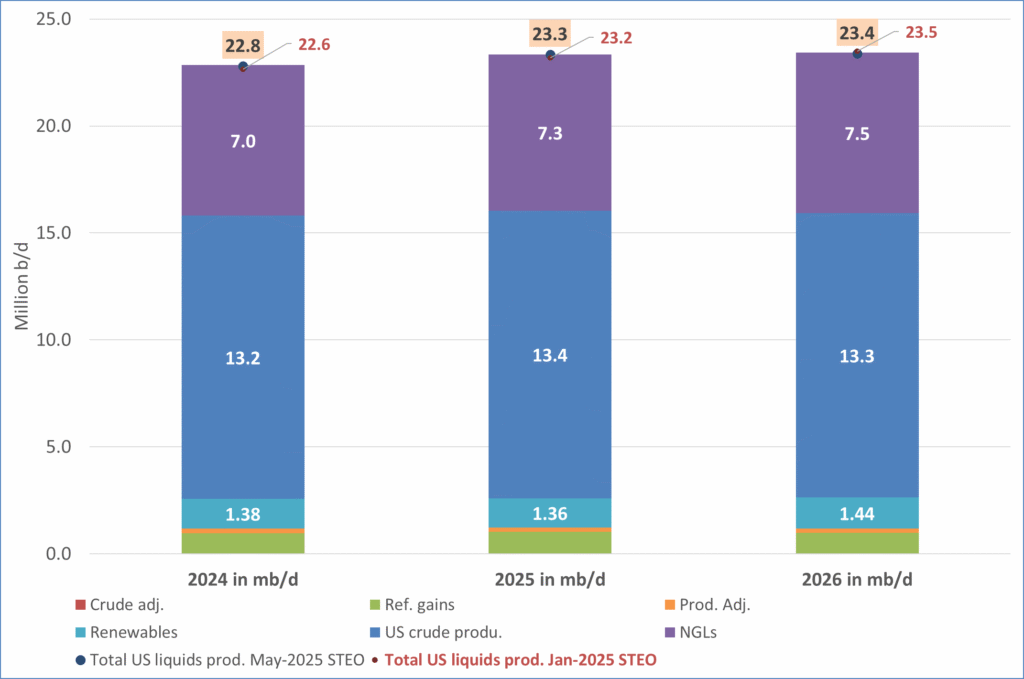
US IEA STEO September report. US crude oil production contracting in 2026, but NGLs still growing. Close to zero net liquids growth in total.
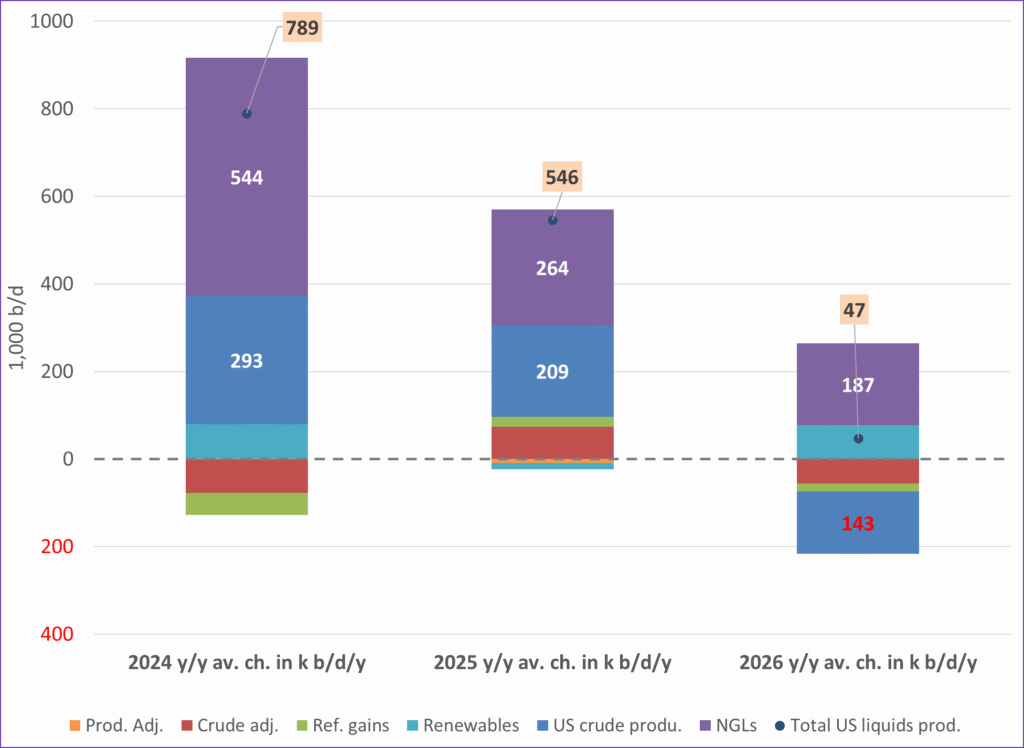
Analys
Brent crude sticks around $66 as OPEC+ begins the ’slow return’

Brent crude touched a low of USD 65.07 per barrel on Friday evening before rebounding sharply by USD 2 to USD 67.04 by mid-day Monday. The rally came despite confirmation from OPEC+ of a measured production increase starting next month. Prices have since eased slightly, down USD 0.6 to around USD 66.50 this morning, as the market evaluates the group’s policy, evolving demand signals, and rising geopolitical tension.

On Sunday, OPEC+ approved a 137,000 barrels-per-day increase in collective output beginning in October – a cautious first step in unwinding the final tranche of 1.66 million barrels per day in voluntary cuts, originally set to remain off the market through end-2026. Further adjustments will depend on ”evolving market conditions.” While the pace is modest – especially relative to prior monthly hikes – the signal is clear: OPEC+ is methodically re-entering the market with a strategic intent to reclaim lost market share, rather than defend high prices.
This shift in tone comes as Saudi Aramco also trimmed its official selling prices for Asian buyers, further reinforcing the group’s tilt toward a volume-over-price strategy. We see this as a clear message: OPEC+ intends to expand market share through steady production increases, and a lower price point – potentially below USD 65/b – may be necessary to stimulate demand and crowd out higher-cost competitors, particularly U.S. shale, where average break-evens remain around WTI USD 50/b.
Despite the policy shift, oil prices have held firm. Brent is still hovering near USD 66.50/b, supported by low U.S. and OECD inventories, where crude and product stocks remain well below seasonal norms, keeping front-month backwardation intact. Also, the low inventory levels at key pricing hubs in Europe and continued stockpiling by Chinese refiners are also lending resilience to prices. Tightness in refined product markets, especially diesel, has further underpinned this.
Geopolitical developments are also injecting a slight risk premium. Over the weekend, Russia launched its most intense air assault on Kyiv since the war began, damaging central government infrastructure. This escalation comes as the EU weighs fresh sanctions on Russian oil trade and financial institutions. Several European leaders are expected in Washington this week to coordinate on Ukraine strategy – and the prospect of tighter restrictions on Russian crude could re-emerge as a price stabilizer.
In Asia, China’s crude oil imports rose to 49.5 million tons in August, up 0.8% YoY. The rise coincides with increased Chinese interest in Russian Urals, offered at a discount during falling Indian demand. Chinese refiners appear to be capitalizing on this arbitrage while avoiding direct exposure to U.S. trade penalties.
Going forward, our attention turns to the data calendar. The EIA’s STEO is due today (Tuesday), followed by the IEA and OPEC monthly oil market reports on Thursday. With a pending supply surplus projected during the fourth quarter and into 2026, markets will dissect these updates for any changes in demand assumptions and non-OPEC supply growth. Stay tuned!
-

 Nyheter4 veckor sedan
Nyheter4 veckor sedanMeta bygger ett AI-datacenter på 5 GW och 2,25 GW gaskraftverk
-
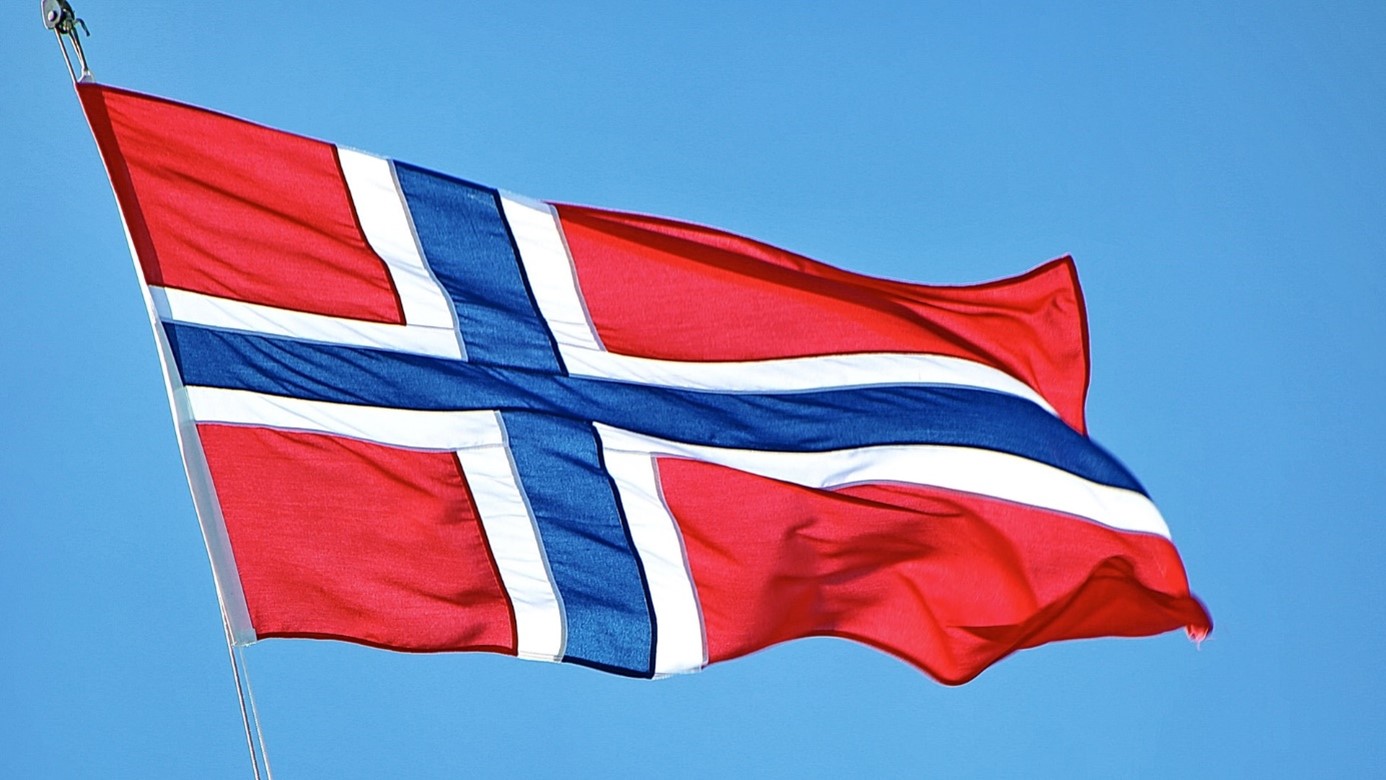
 Nyheter4 veckor sedan
Nyheter4 veckor sedanAker BP gör ett av Norges största oljefynd på ett decennium, stärker resurserna i Yggdrasilområdet
-

 Analys4 veckor sedan
Analys4 veckor sedanBrent sideways on sanctions and peace talks
-

 Nyheter4 veckor sedan
Nyheter4 veckor sedanEtt samtal om koppar, kaffe och spannmål
-

 Nyheter4 veckor sedan
Nyheter4 veckor sedanSommarens torka kan ge högre elpriser i höst
-

 Analys4 veckor sedan
Analys4 veckor sedanBrent edges higher as India–Russia oil trade draws U.S. ire and Powell takes the stage at Jackson Hole
-
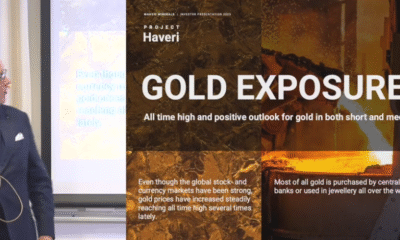
 Nyheter3 veckor sedan
Nyheter3 veckor sedanMahvie Minerals är verksamt i guldrikt område i Finland
-

 Analys3 veckor sedan
Analys3 veckor sedanIncreasing risk that OPEC+ will unwind the last 1.65 mb/d of cuts when they meet on 7 September


